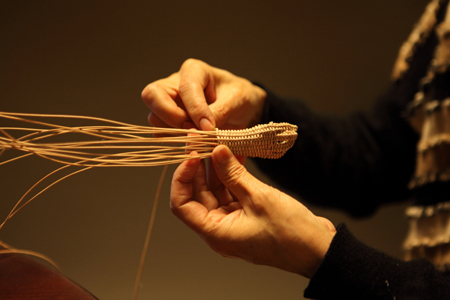1. What is Rattan?
Rattan is the stem or trunk of a climbing palm, which is a native of tropical
rainforest. Rattan grows in a long and slender stem, by clinging to other
trees
in jungles by its long leaves with barbed tips and is considered to be
the longest plant on earth. It is full of vitality and grows in vast areas
such as Malaya, India,
China and other south Asian countries.
In Japan, Rattan is not native and
imported from overseas.
Rattan consists of the outer bark and the inner reed. The inner reed is
dried and split into stripes called as cane(called “marushin” in Japanese)
with the diameter of 1mm to 1.5mm.
2.
The History of Rattan Art in Japan
In feudal days, Rattan was a precious material, as its importation was limited
due to Japan’s isolation policy at the time, and used mainly in the tea set
in tea ceremony and in the handle of Katana(Japanese sword),
taking advantage of its strength and flexibility.
In the Meiji
era when Japan’s isolation policy was ended, Rattan became
available to the general public and Rattan furniture started being popular.
Though its use was declined substantially by the end of the War,
it was known that Rattan got its popularity again when the American
occupation army brought Rattan furniture in Japan in high
volumes.
3.
Rattan Doll
The efforts to use Rattan for the purpose of art such as making elegant
dolls
are rather new, so Rattan Doll is classified not as traditional handicrafts
but as contemporary handicrafts.
Sae Morimoto, Rattan Doll Artist, uses not only the hand weaving method
which is based upon the art of weaving baskets but also the coiling method
used in the making of traditional tea sets and/or sword handles, and creates
the high quality Rattan Dolls which are as elegant as only seen in fairly
tales.

|